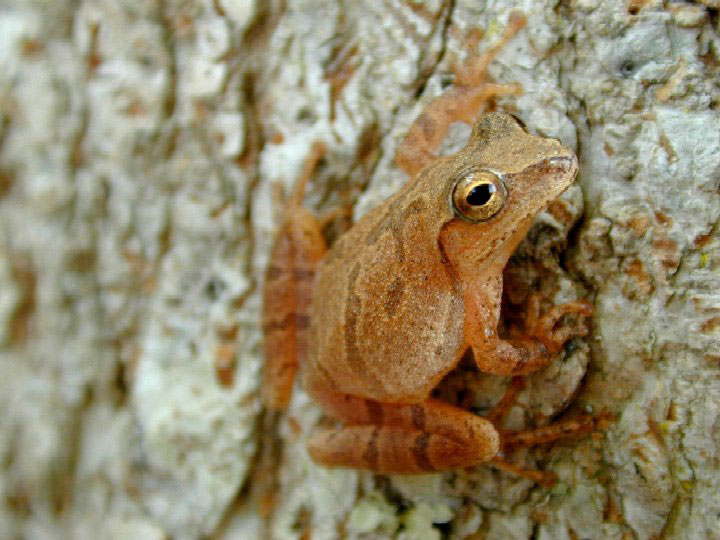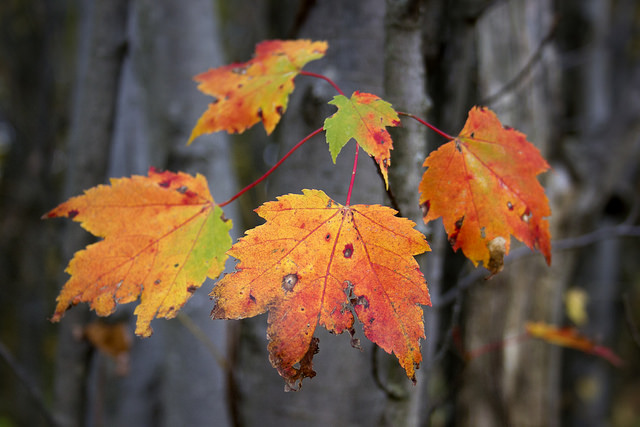Bluebirds murmur as they investigate the nest box, their solemn songs melodic in the morning fog. A White-throated Sparrow joins in from the edge of the pasture, clear and crystal. Faintly a Ruffed Grouse drums, and the peepers call with gusto from the pond. Dandelions appear scattered on the lawn, pointing their heads to the sunlight that will soon come and warm them to opening.

Bluebird waiting on a nest box. Photo by Katie Finch.
I find it intriguing that I could probably write that exact same paragraph about late April and early October. If I close my eyes, the day is virtually the same, save scent. Now a loamy, older, rich, fallen leaf smell wafts through the air whereas in spring it is an earthy, new, wet aroma. Temperature is a about the same, weather is about the same, variable and constantly changing. I can hardly fault the flora and fauna for getting a smidgen confused as the day length reaches spring proportions.
The phenomena has a name, autumnal recrudescence, and I feel it as well. While a naturalist is hard pressed to choose a favorite season, I am torn between spring and autumn. At times I truly think I am solar powered. My energy levels are so much higher when the sun is out. But I am off topic, back to autumnal recrudescence.
Many animals, especially birds, have hormone levels that vary with the amount of light during the day. This helps them to all enter breeding condition at the same time, thus improving the odds of reproduction. It is brilliant, really, as the rotation and revolution of the Earth are much less fickle than weather or even climate. However, there are a few weeks of confusion. Not enough to bring birds into breeding plumage as the days have been getting shorter leading up the fall equinox, but enough to prompt them to sing, investigate nesting sites, and even start building nests in some cases though they rarely finish.
With the clear birdsong of spring mornings also comes the effort of the young male birds attempting to sing. Let’s just say that it is good that they have a few more months to practice before their skills are judged by the females.
Frogs also sing more as fall settles in and the days mimic spring. Spring Peepers and Gray Tree Frogs are the two that seem to be most affected by the seasonal change, though on warm, rainy nights, there are almost as many frogs on the roads as there are in April.
People can also feel the effect of lessening daylight, some severely so. The lessening of daylight affects people much more rarely since the invention of the light bulb. While prior to electricity candles were used, the light was often not bright enough to replicate daylight. With lightbulbs and electricity, humans essentially lit themselves away from the natural circadian rhythms.
I mentioned before that I have so much more energy when the sun is out. That means that as winter wanes I get antsy to be busy and get things done and be active. This plays throughout the summer, as the nights continue to shorten and the productive time of the day lengthens. It also means that I am not sorry to see the fall equinox approach because I am tired, so very tired. I think this is why spring and fall are my favorite – I have a good amount of light to work within and an equal amount of darkness to both wind up and down and rest. Does this mean in the winter I go to bed at 7:30 p.m.? Perhaps…

Spring Peepers and other frogs sing in the fall as they do in the spring.
So what’s going on? For some people the effect of seasonal change is dramatic and detrimental. Often called the winter blues, some people have been diagnosed with a severe case of it called Seasonal Affective Disorder. This depression often happens in the fall, but can happen at any seasonal change. What scientists think happens is that the level of melatonin produced (a sleep inducing hormone) increases as daylight shortens. This leads to depressed levels of activity, and often mood. This occurs in many species that hibernate, go dormant, or significantly change their level of activity in the winter, and leaner, months. It can also play a role in decreased reproduction and libido but that is a whole separate article.
So what can you do? Go outside in the late fall and winter more often. Yes, I know it is cold but the natural light is good for you. Tip your face up to the winter sun and enjoy the season. You can also be more active, exercise more, and adopt winter hobbies that involve moving around more. You can also use full-spectrum lights designed to mimic sunlight and sit in front of those if you absolutely cannot bring yourself to go outside.
Finally, you can embrace the change as the natural world does. Engage in autumnal recrudescence. Channel your inner bluebird but let your inner bear take over once the excitement of equal light-dark days passes. Sing your heart out for a few weeks and celebrate the energy before burrowing into your home and perhaps going to bed a little earlier…
Audubon Community Nature Center builds and nurtures connections between people and nature. ACNC is located just east of Route 62 between Warren and Jamestown. The trails are open from dawn to dusk as is Liberty, the Bald Eagle. The Nature Center is open from 10 a.m. until 4:30 p.m. daily except Sunday when it opens at 1 p.m. More information can be found online at auduboncnc.org or by calling (716) 569-2345.
Sarah Hatfield is a naturalist at ACNC.


Recent Comments